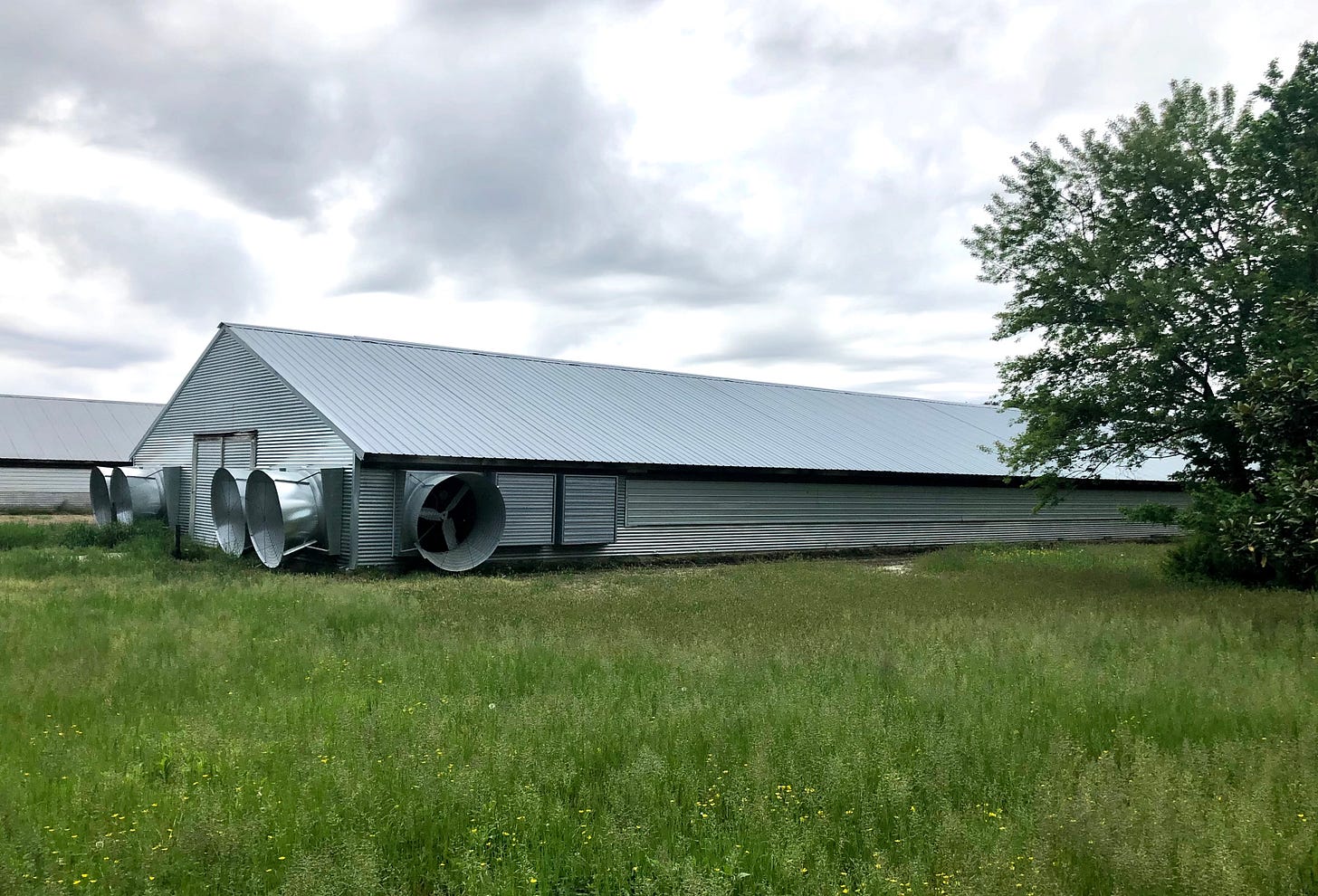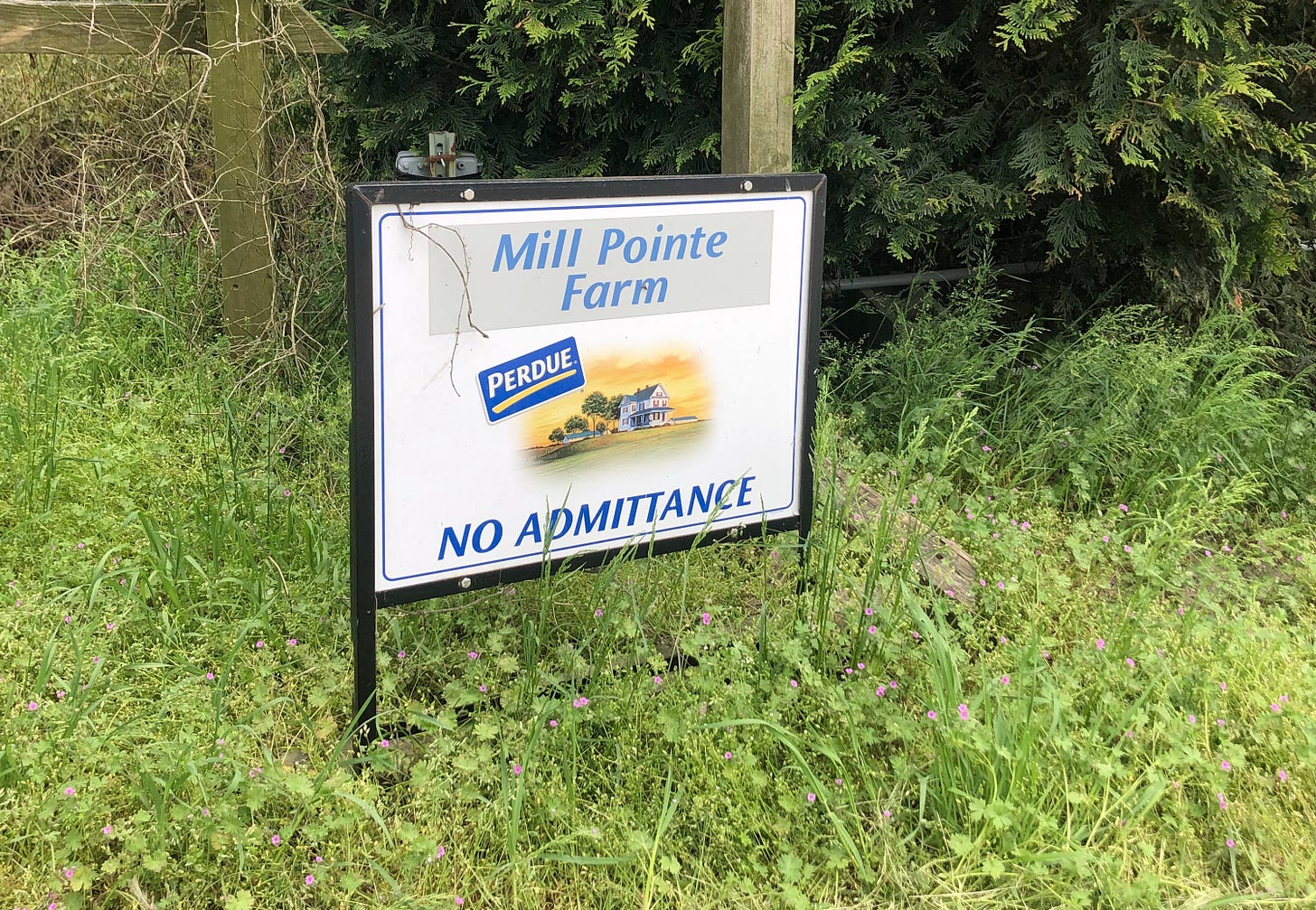A surprising court ruling affirms one of industrial chicken farming's invisible impacts
A Maryland judge says the connection between ammonia emissions and water pollution is clear.
Even when you’re up close, it’s difficult to get a real picture of what it means to raise hundreds of thousands of chickens in one of the many Concentrated Animal Feeding Operations (CAFOs) on Maryland’s Eastern Shore. There are “no admittance” signs at the end of each driveway, beyond which sit a row or cluster of hulking, windowless metal buildings. Most of the time there are very few people around, and everything’s quiet aside from the whir of large industrial fans. Those fans blow ammonia, an invisible gas emitted from chicken waste, out of the barns.
Some of that ammonia—which is a form of nitrogen—hits soil or water and ends up in the Chesapeake Bay.
Overall, 300 million pounds of nitrogen enters the Bay each year, where it contributes to algal blooms and “dead zones” where aquatic species can’t survive. Agriculture is the largest source of nitrogen (although the amount of polluted runoff from cities and suburbs is rising), but efforts to clean it up primarily focus on reducing nitrogen runoff from farm fields. Ammonia from CAFOs is rarely mentioned in this context, and federal and state agencies don’t track or regulate emissions.
Now, a state judge has decided that needs to change.
In a case brought by the Assateague Coastal Trust, Judge Sharon Burrell agreed with the local conservation group’s argument that ammonia emissions from Maryland’s chicken houses should be regulated under the national Clean Water Act, which authorizes states to regulate water pollution. Judge Burrell said the state had chosen to strengthen provisions of the law within its borders to include gases as water pollutants and that the evidence of ammonia’s effects were clear. “The record in this case indicates that there is a definite and real impact on the Bay,” she wrote.
It’s a ruling that could have far-reaching ramifications because of the judge’s acknowledgment of the scientific (and legal) connection between air pollutants and impacts on waterways.
“This decision is precedent-setting and could have an impact beyond Maryland. We know that factory farms all over the country emit vast quantities of ammonia that not only harms public health in rural communities, but also re-deposits in waterways, contributing to excess nitrogen that causes algal blooms and harms aquatic ecosystems,” Tarah Heinzen, the legal director for Food & Water Watch, told Peeled. “EPA has long failed to use its authority under clean air laws to regulate air pollution from the industry, so regulating ammonia discharges under the Clean Water Act would be a good start to finally limiting these dangerous emissions.”
To be clear, that’s not going to happen overnight, and this ruling is likely to be appealed and could be overturned.
In a statement accusing the Coastal Trust of taking millions of dollars to fund “anti-agriculture” lawsuits, Executive Director Holly Porter said the Delmarva Chicken Association (DCA) “fully expects the state of Maryland to appeal this decision and see that the Maryland Department of the Environment's (MDE) AFO permit–which received the Environmental Protection Agency's approval during review–is sustained by a higher court.” She continued, "While Maryland farmers work hard to achieve environmental progress, including sustained reductions in nutrients delivered to the Chesapeake Bay, these activists remain determined to put hundreds of farm families out of work by eradicating chicken farming on the Eastern Shore."
To understand Porter’s fighting words, you’ve got to have a sense of the place in which DCA is operating and how the issue of ammonia emissions has played out up until now.
The Delmarva Peninsula is a small land mass on the Eastern side of the Chesapeake Bay that includes Delaware, part of Maryland, and part of Virginia. The Southern part, especially, is incredibly flat and fairly isolated. After a plucky fellow name Arthur Perdue started raising chickens there about a century ago, the industry began to expand. Today, according to DCA, the peninsula is home to 5,000 barns, in which 570 million chickens are produced annually. In addition to Perdue Farms, growers raise chickens for Tyson and Mountaire, and there are multiple processing plants in the region. Other regions in the country produce more poultry, but not in such a small area with such a high level of concentration.
As a result, the industry often butts heads with environmental advocates and local residents, who fault the scale and style of production for contributing to Bay pollution and quality of life issues like odors and flies.
In 2019, I drove out there on assignment from Civil Eats to hear about why residents were concerned about ammonia emissions. In that case, I was talking to residents who lived a stone’s throw from multiple large CAFOs and were concerned about breathing it in. Exposure to ammonia is associated with negative health effects at certain levels, but there was no data on how much was actually making its way into the air people were breathing while gardening or grilling in their yards. So residents wanted state agencies to monitor levels in the air. After a legislative battle involving DCA, MDE, and various advocacy groups and local residents, MDE set up a monitoring program that was a pared down version of what residents and health experts had called for. (There are now some numbers available, but I didn’t have time to ask questions about what they indicate for this story, so I’m leaving that out for now to focus on nitrogen.)
What I didn’t know at the time was that the Chesapeake Bay Foundation (CBF) had also commissioned a study on ammonia emissions looking at a completely different issue. “We believed that it was a large source of nitrogen coming into the bay,” said Beth McGee, CBF’s director of science and agricultural policy. “We knew roughly a third of the nitrogen coming into the Bay was coming from the air,” she explained. One major source was nitrous oxides from the combustion of fossil fuels, via cars and power plants. But with ammonia from animal agriculture, “we were concerned that it was largely unaddressed. We had some questions about the science around how much would be emitted and deposited.”
Researchers at North Carolina State University created a model to estimate those numbers, and the study was published in December 2019. They found that Maryland’s Eastern Shore poultry houses emit about about 33.8 million pounds of ammonia per year, with about 24.4 million pounds deposited to local land and water. The model had significant limitations: It assumed poultry houses have chickens in them 365 days per year (they don’t) and didn’t take into account “litter amendments” some farmers use to reduce ammonia.
For that reason, the Maryland estimates are likely too high. But McGee pointed out that they also only looked at the one state, and there are chicken CAFOs in Delaware, Virginia, and in Pennsylvania, so the overall amount getting into the Bay is likely much higher.
And she said that understanding how widely practices like litter amendments are being adopted and how significantly they reduce emissions is a next step, but researchers won’t be able to get that information without the industry’s help. “That is something that we're interested in learning more about, and we're hoping we can get that information from the industry,” she said.
In her decision last week, Judge Burrell cited CBF’s study on ammonia emissions as evidence. And if Maryland begins regulating ammonia from chicken CAFOs based on her ruling, that could mean more accurate data will become available, bringing one aspect of industrial chicken farming’s impacts a little bit more into focus.
A side of policy
An historic confirmation. Deb Haaland officially became the first Native American to serve in the US cabinet when she was confirmed to serve as President Joe Biden’s Secretary of the Interior this week. Haaland, who is a member of the Pueblo of Laguna tribe, will now oversee tribal lands, where food insecurity, food sovereignty, diet-related diseases, and conservation are key issues.
In the past, as a member of Congress representing New Mexico, Holland spoke publicly about relying on SNAP benefits and worked to expand those benefits, including improving access on reservations. She has said she’ll prioritize enviromental justice, and many tribes are working on efforts to rebuild indigenous food systems on their lands. Last year, she also introduced a House resolution calling for a “farmer’s bill of rights” intended to give individual farmers more power against powerful agriculture companies.


Still hungry?
Radishes on rooftops, greens in garages. On the Farm Report, I interviewed the hosts of another podcast (I know, so many podcasts), Fields, about their work in urban farming. Melissa Metrick runs NYU’s Urban Farm Lab in Manhattan and Wythe Marschall conducts research on urban agriculture. Together, they’ve been digging into what farming in cities looks like, from massive venture capital-funded vertical farms and rooftop CSA operations to community gardens and windowsill pots. I was especially into our conversation about the many reasons beyond sustenance that people choose to grow food in urban environments. Here’s the link on Heritage Radio, or you can search for The Farm Report, Episode 417, “Untold Stories of Urban Farming,” wherever you listen to podcasts.
Currently devouring
New body, who dis? I heard this segment on NPR last Saturday and couldn’t stop thinking about it all week. Basically, scientists discovered a sea slug that, when it gets overtaken by parasites, tears its own head away from its body, ditches said compromised body, and then grows itself a new one. This story isn’t about food at all, but it is about the unbelievable, wild wisdom of nature. And remembering and respecting that wisdom and complexity is key to building healthy food systems that can actually last. Like, hey, you think you can outsmart nature with your one-dimensional, super-smart tech fixes? This slug can regrow its entire body, no biggie.
Actually eating
One night this week, I used this recipe as a jumping off point because I had some sweet potatoes that I needed to use and always have a big container of lentils in the pantry. I eliminated multiple steps by chopping the sweet potatoes and putting the glaze on them five minutes before I took them out of the oven. I didn’t have sesame oil so I put ground sesame seeds on top. And I added feta, because I like it.
Two takeaways: Whether you follow the recipe or just throw things together, roasted sweet potatoes and lentils are a great combo for an easy, delicious meal. And glazing sweet potatoes with some sort of miso situation is always a good idea.
Let’s be friends
Follow me on Twitter and Instagram to continue the conversation. See you next week!






